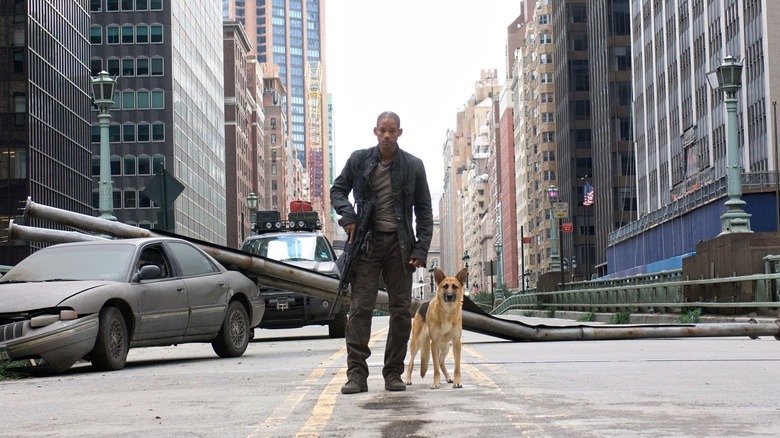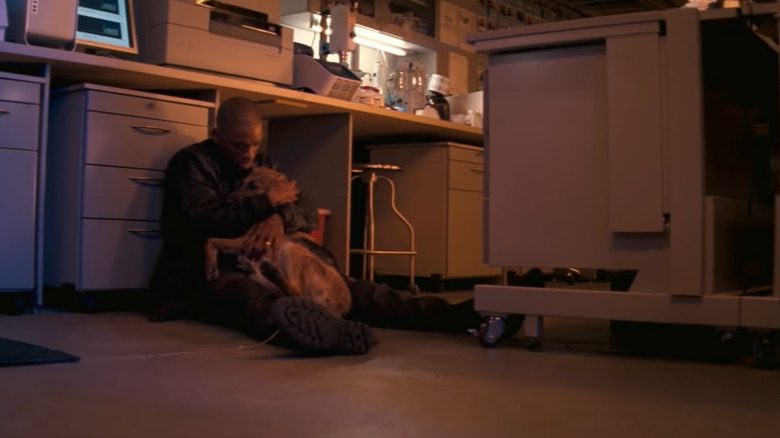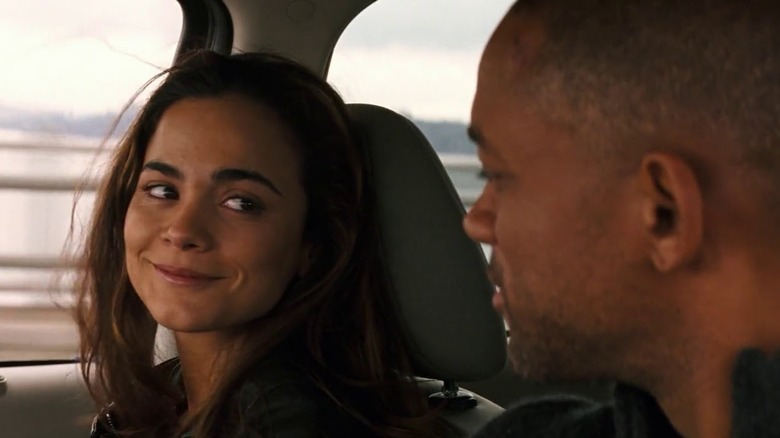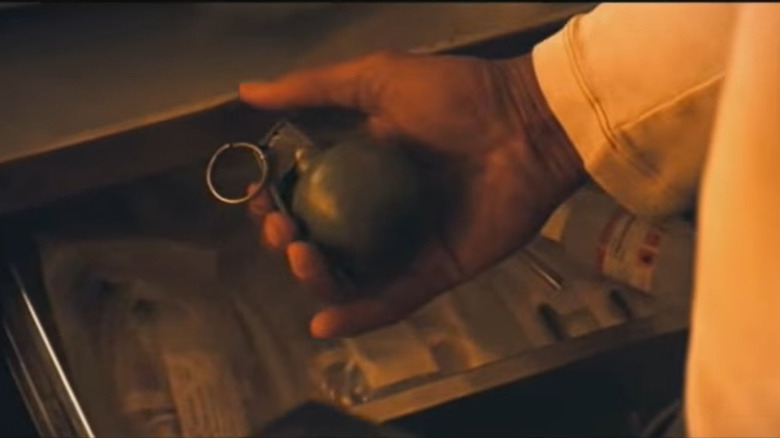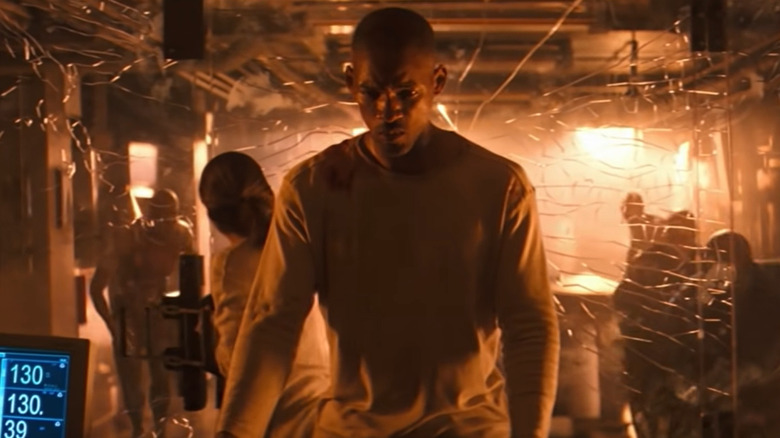I Am Legend Showcases The Folly Of Not Using The Greatest Horror Ending Of All Time
A lot of the best horror movies of all time were ones that were deeply unfaithful to the book. 2007's "The Mist" completely changed the ending to Stephen King's novella, going for a shocking, gut-wrenching plot twist rather than the source material's more hopeful, ambiguous conclusion. Stanley Kubrick's adaptation of "The Shining" also changed the source material, especially the ending, which resulted in one of the most beloved horror films of all time. King himself had mixed feelings about these movies (he loved the former's change, hated the latter), but the general reception made things clear: an adaptation doesn't always have to be faithful to make for a good movie.
But then there are movies like 2007's "I am Legend," a film that also changes a ton from the book it was based on, but not in a good way. "The Mist" ending change helped to hammer home the story's core themes of paranoia and the importance of maintaining hope. The changes in "The Shining" still stayed true to the book's sense of growing paranoia and claustrophobia. Meanwhile, the ending of "I Am Legend" only served to water down the themes of the book. Richard Matheson wrote one of the most memorable, intense, and thought-provoking endings of all time, and the movie scrapped it completely.
Some early red flags
In spite of everything, the first two-thirds of "I Am Legend" are pretty great. It's different, but it's still got that same sense of dread and loneliness as the original novel. Robert Neville in the book has been going a little crazy as a result of being completely on his own for so long, and Will Smith gets that same sense across with his performance here. Like the book, the movie also conditions you to be terrified of the dark. The movie also makes the smart choice of giving Neville a dog from the very beginning, rather than meeting the dog and slowly befriending it as he does in the book. A movie only has so much time to develop Neville's relationship with his dog before the dog inevitably dies, after all, and it gives Neville someone to talk to now that we don't have the book's access to his inner thoughts.
However, there were some choices made from the beginning that should've warned us of the bad ending that would come. The first was the decision to de-personify the vampires. In the book, the vampires were intelligent and capable of talking the whole time. The book's vampires would use their speech to try to coax Neville out of his home each night, whereas the movie's vampires just sort of thrash around and let out animalistic screams. They're closer to the sort of fast zombies you'd see in "28 Days Later" than the vampire-like creatures Neville encounters in the book. Both versions are terrifying, but the book's depiction is more interesting because its monsters are clearly intelligent and, as a result, are more sympathetic from the get-go.
The far bigger red flag, however, was the introduction of Anna.
The loss of Ruth
As soon as Anna (Alice Braga) and a young child named Ethan (Charlie Tahan) appear in the film, it's clear that the two characters are kind and trustworthy people. They plan to travel up to a survivor's camp in Vermont, which the movie would later confirm is real. There's certainly some conflict and mistrust between Anna and Neville, but nothing too serious.
In the book, however, there is no Anna or Ethan. There's only Ruth, a woman who shows up nearly two-thirds of the way through, and who Neville instantly suspects of being one of the vampires. (In the book, the fact that she can speak isn't enough to prove she's not infected.) Their relationship is tense but then slowly turns romantic, right until Neville convinces her to let him test her blood. She knocks him out before he can look at the results and runs away, but not before leaving a note explaining that yes, she is in fact a vampire.
As it turns out, there are two types of vampires in the novels: those who died when they were infected and turned into vampires afterward, and those who stayed alive the whole time. The former are violent and irrational, but the latter are still as smart as regular humans and have built a new society together. But because Neville hasn't known about the difference, he's been killing both types of vampires indiscriminately throughout the novel, and one of those vampires was Ruth's husband.
The book ends with Neville being captured by the living vampires and sentenced to death for his crimes against them. He realizes that from their perspective, he was the monster terrorizing them in the middle of the night. To them, he's the scary vampire that needs to be killed.
Movie Neville's sacrifice
All of that moral complexity is gone in the movie's ending. "I Am Legend" concludes Neville's character arc by having him heroically blow himself up to kill all the vampires trying to break into his lab, allowing Anna and Ethan to escape and bring the cure to the survivor's camp. The movie ends with Anna giving a monologue about how he saved humanity. "We are his legacy," she says, "and this is his legend."
It's a far cry from the book's ending, in which Neville thinks to himself in his final moments, "I am legend." The book's ending is haunting not just because it ends with the hero's death, but because he dies with the realization that he was never really the hero in the first place. He spent the whole book killing living, sentient creatures capable of kindness and rational thought, and dies with the understanding that the last few years of his life were spent pursuing a pointless goal. There was no hope of rebuilding human society, because humans were no longer the dominant species on Earth. The world had moved beyond humans, and that wasn't even necessarily a bad thing.
In comparison, the movie makes things way too easy. Neville's worldview is never challenged in a meaningful way. He gets to be the lone hero he sees himself as throughout the film, with no subversion or moment of doubt. The new society being formed in the movie is made up of regular humans who we're told would learn to think of Neville as their savior. Not only that, but the indications throughout the film that the vampires are more intelligent than the rabid animals they come across as don't end up leading anywhere. In the end, they're just monsters that need to die.
The alternate ending
The movie changes so much from the book at the end that it begs the question: why'd they even bother adapting "I Am Legend" in the first place? Why not just create their own original vampire film, if this was where they planned to take the story?
This is why many viewers point to the film's alternate ending as the superior one. In the alternate ending, one of the vampires trying to break into his lab makes a butterfly symbol in the glass, which leads Neville to realize he's referencing the butterfly tattoo on his test subject's neck. Taking this as a sign that these creatures are more intelligent than they originally seemed, Neville opens the door and returns the test subject to the main vampire, who appears to be her loving partner. Even though the monsters could now easily kill him, they decide to forgive Neville and leave him alone.
Much like his book counterpart, this Neville realizes that he's the monster in the eyes of these creatures. These are sentient beings who know he's been killing and kidnapping their friends and family. And even though they think he's a monster, they still show him compassion and spare his life, which was more than he ever did for them.
Although this ending still lacks the gut-punch of the book's finale, it at least covers the same basic thematic ground. This is why the ending the original movie went with is so disappointing: even if they weren't going to stay true to the book, they still had the chance to have an ending that actually said something interesting or gave viewers something real to think about. Instead, they went for the safer, blander route, and the whole film suffers for it.
